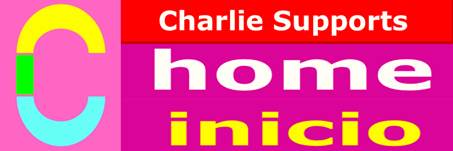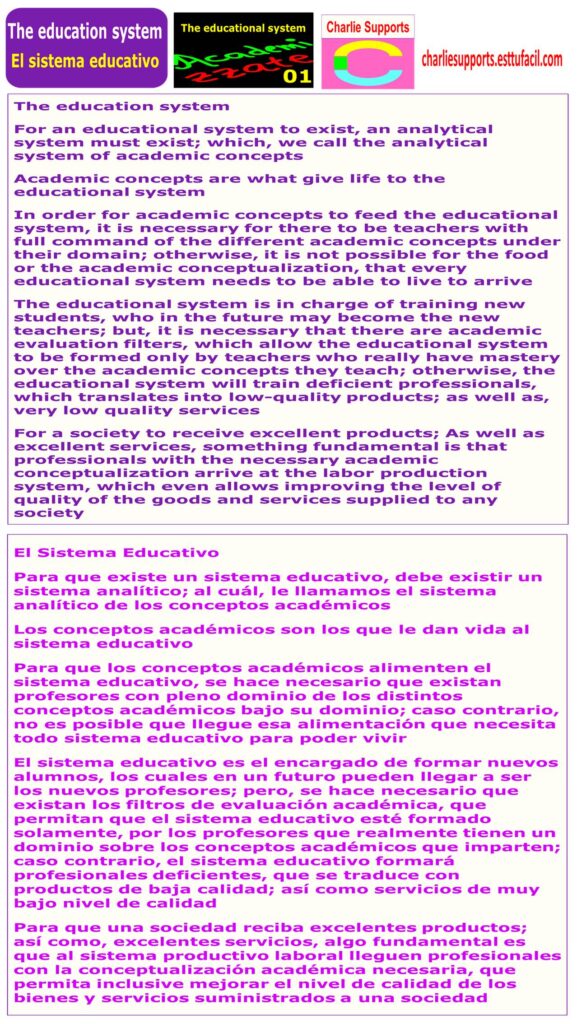
The educational system
by Charlie Supports
For an educational system to exist, an analytical system must exist; which, we call the analytical system of academic concepts
Academic concepts are what give life to the educational system
In order for academic concepts to feed the educational system, it is necessary for there to be teachers with full command of the different academic concepts under their domain; otherwise, it is not possible for the food or the academic conceptualization, that every educational system needs to be able to live to arrive
The educational system is in charge of training new students, who in the future may become the new teachers; but, it is necessary that there are academic evaluation filters, which allow the educational system to be formed only by teachers who really have mastery over the academic concepts they teach; otherwise, the educational system will train deficient professionals, which translates into low-quality products; as well as, very low quality services
For a society to receive excellent products; As well as excellent services, something fundamental is that professionals with the necessary academic conceptualization arrive at the labor production system, which even allows improving the level of quality of the goods and services supplied to any society
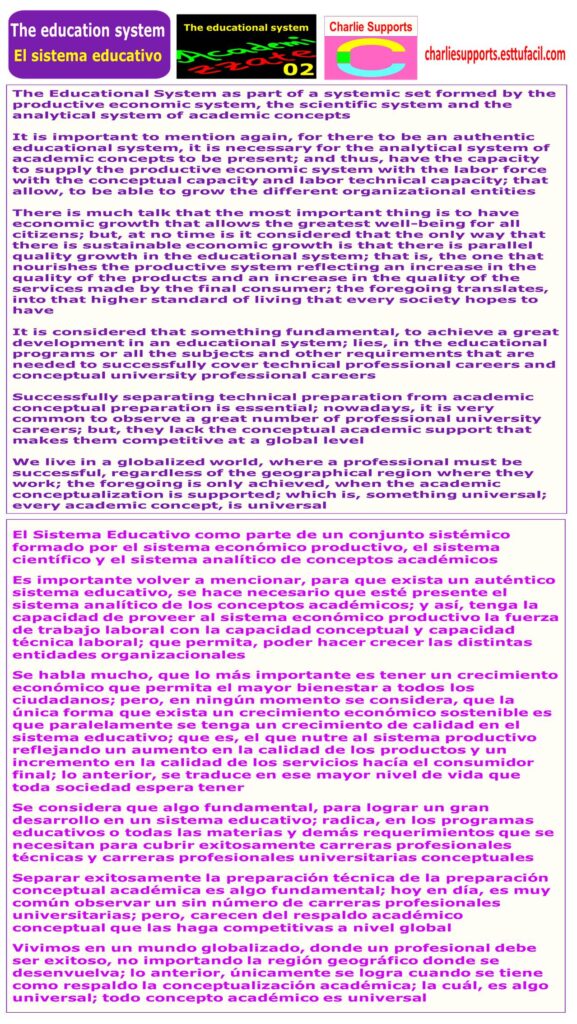
The Educational System as part of a systemic set formed by the productive economic system, the scientific system and the analytical system of academic concepts
It is important to mention again, for there to be an authentic educational system, it is necessary for the analytical system of academic concepts to be present; and thus, have the capacity to supply the productive economic system with the labor force with the conceptual capacity and labor technical capacity; that allow, to be able to grow the different organizational entities
There is much talk that the most important thing is to have economic growth that allows the greatest well-being for all citizens; but, at no time is it considered that the only way that there is sustainable economic growth is that there is parallel quality growth in the educational system; that is, the one that nourishes the productive system reflecting an increase in the quality of the products and an increase in the quality of the services made by the final consumer; the foregoing translates, into that higher standard of living that every society hopes to have
It is considered that something fundamental, to achieve a great development in an educational system; lies, in the educational programs or all the subjects and other requirements that are needed to successfully cover technical professional careers and conceptual university professional careers
Successfully separating technical preparation from academic conceptual preparation is essential; nowadays, it is very common to observe a great number of professional university careers; but, they lack the conceptual academic support that makes them competitive at a global level
We live in a globalized world, where a professional must be successful, regardless of the geographical region where they work; the foregoing is only achieved, when the academic conceptualization is supported; which is, something universal; every academic concept, is universal
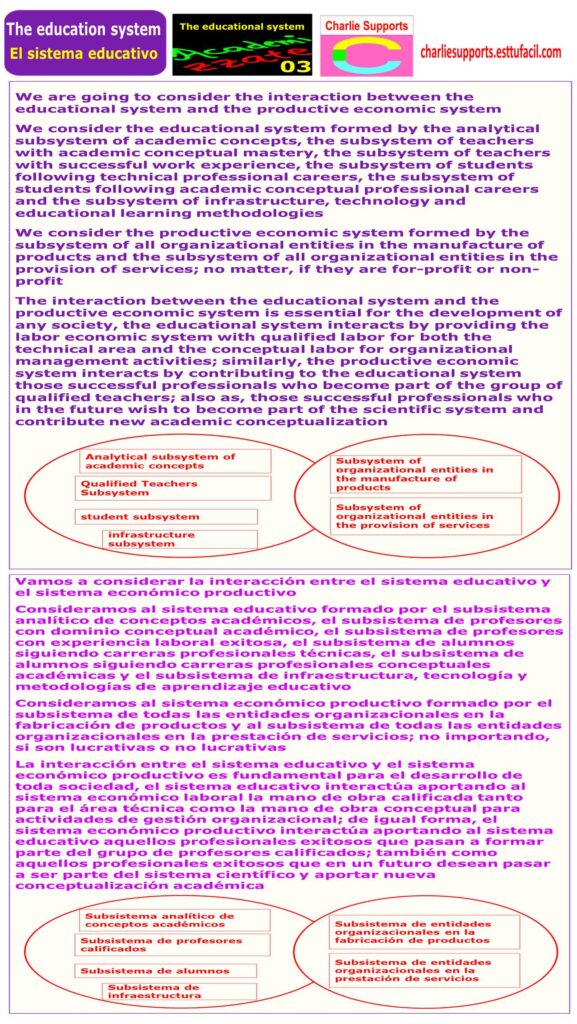
We are going to consider the interaction between the educational system and the productive economic system
We consider the educational system formed by the analytical subsystem of academic concepts, the subsystem of teachers with academic conceptual mastery, the subsystem of teachers with successful work experience, the subsystem of students following technical professional careers, the subsystem of students following academic conceptual professional careers and the subsystem of infrastructure, technology and educational learning methodologies
We consider the productive economic system formed by the subsystem of all organizational entities in the manufacture of products and the subsystem of all organizational entities in the provision of services; no matter, if they are for-profit or non-profit
The interaction between the educational system and the productive economic system is essential for the development of any society, the educational system interacts by providing the labor economic system with qualified labor for both the technical area and the conceptual labor for organizational management activities; similarly, the productive economic system interacts by contributing to the educational system those successful professionals who become part of the group of qualified teachers; also as, those successful professionals who in the future wish to become part of the scientific system and contribute new academic conceptualization
Educational system interaction
Analytical subsystem of academic concepts
Qualified Teachers Subsystem
student subsystem
infrastructure subsystem
Subsystem of organizational entities in the manufacture of products
Subsystem of organizational entities in the provision of services
Productive economic system interaction
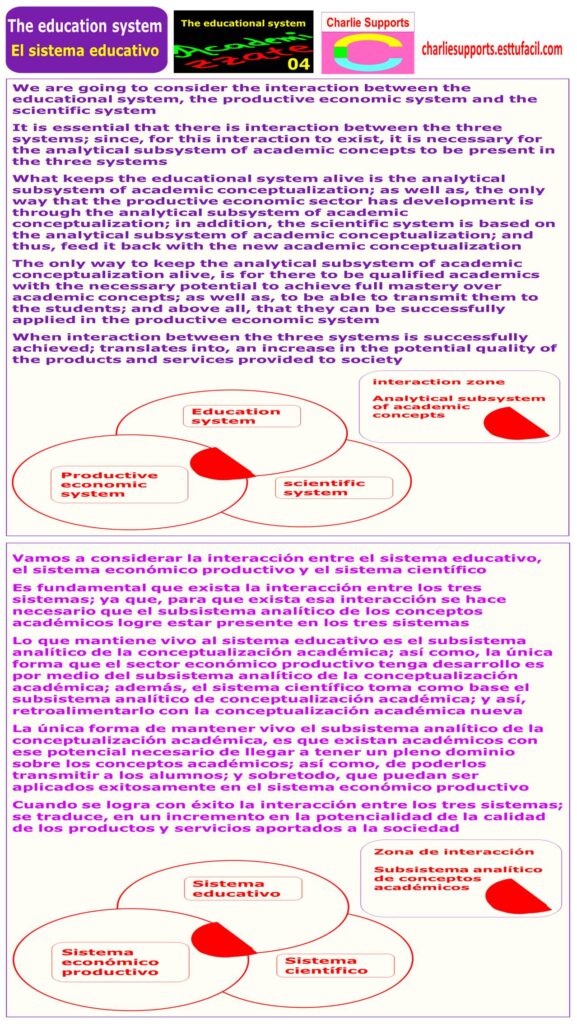
We are going to consider the interaction between the educational system, the productive economic system and the scientific system
It is essential that there is interaction between the three systems; since, for this interaction to exist, it is necessary for the analytical subsystem of academic concepts to be present in the three systems
What keeps the educational system alive is the analytical subsystem of academic conceptualization; as well as, the only way that the productive economic sector has development is through the analytical subsystem of academic conceptualization; in addition, the scientific system is based on the analytical subsystem of academic conceptualization; and thus, feed it back with the new academic conceptualization
The only way to keep the analytical subsystem of academic conceptualization alive, is for there to be qualified academics with the necessary potential to achieve full mastery over academic concepts; as well as, to be able to transmit them to the students; and above all, that they can be successfully applied in the productive economic system
When interaction between the three systems is successfully achieved; translates into, an increase in the potential quality of the products and services provided to society
interaction between educational system, productive economic system and scientific system
interaction zone
Analytical subsystem of academic concepts
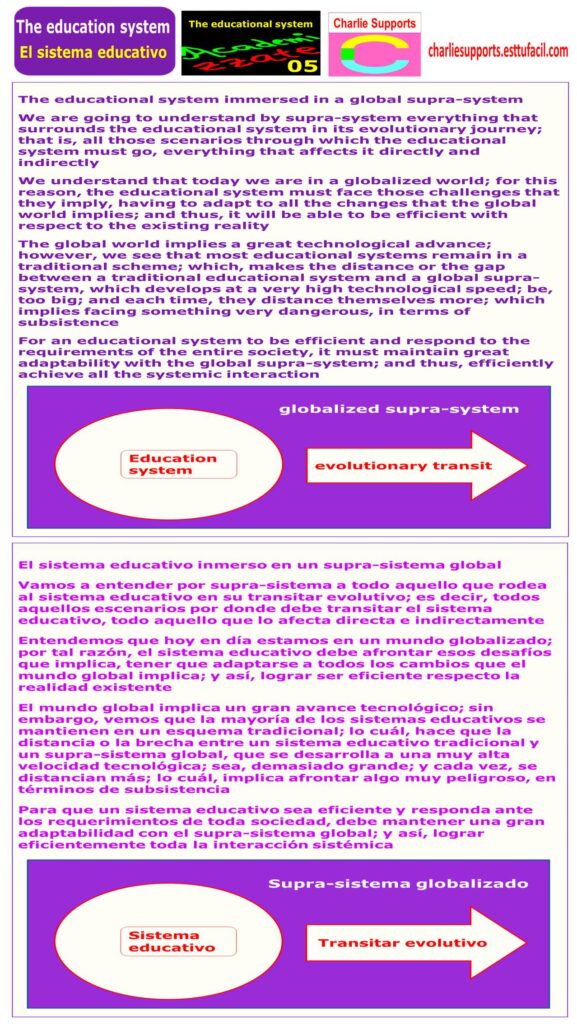
The educational system immersed in a global supra-system
We are going to understand by supra-system everything that surrounds the educational system in its evolutionary journey; that is, all those scenarios through which the educational system must go, everything that affects it directly and indirectly
We understand that today we are in a globalized world; for this reason, the educational system must face those challenges that they imply, having to adapt to all the changes that the global world implies; and thus, it will be able to be efficient with respect to the existing reality
The global world implies a great technological advance; however, we see that most educational systems remain in a traditional scheme; which, makes the distance or the gap between a traditional educational system and a global supra-system, which develops at a very high technological speed; be, too big; and each time, they distance themselves more; which implies facing something very dangerous, in terms of subsistence
For an educational system to be efficient and respond to the requirements of the entire society, it must maintain great adaptability with the global supra-system; and thus, efficiently achieve all the systemic interaction
Education system
evolutionary transit
globalized supra-system
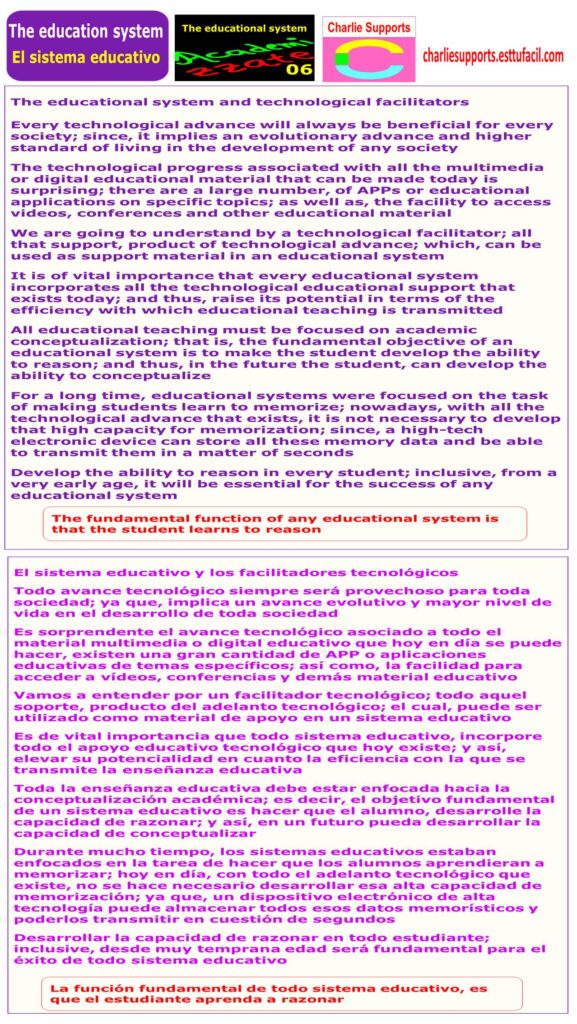
The educational system and technological facilitators
Every technological advance will always be beneficial for every society; since, it implies an evolutionary advance and higher standard of living in the development of any society
The technological progress associated with all the multimedia or digital educational material that can be made today is surprising; there are a large number, of APPs or educational applications on specific topics; as well as, the facility to access videos, conferences and other educational material
We are going to understand by a technological facilitator; all that support, product of technological advance; which, can be used as support material in an educational system
It is of vital importance that every educational system incorporates all the technological educational support that exists today; and thus, raise its potential in terms of the efficiency with which educational teaching is transmitted
All educational teaching must be focused on academic conceptualization; that is, the fundamental objective of an educational system is to make the student develop the ability to reason; and thus, in the future the student, can develop the ability to conceptualize
For a long time, educational systems were focused on the task of making students learn to memorize; nowadays, with all the technological advance that exists, it is not necessary to develop that high capacity for memorization; since, a high-tech electronic device can store all these memory data and be able to transmit them in a matter of seconds
Develop the ability to reason in every student; inclusive, from a very early age, it will be essential for the success of any educational system
The fundamental function of any educational system is that the student learns to reason

The first step of any educational system in its journey through the global supra-system should be to teach the student to reason
Learning to reason is fundamental in all educational development
It is not possible to reason if you do not have the ability to analyze; it is for this reason, the first thing that the educational system must achieve in the student, is that he can achieve the ability to analyze
Achieving in a child the capacity for analysis is fundamental; since, the earlier the ability to analyze is developed, the higher educational development can be expected
Let’s generalize the rational parse function
To analyze, the first thing that must be achieved is to learn to observe carefully; it is not the same, to look at a whole than to observe carefully considering all the possible details; depending, on what is under analysis we can extend to our other senses; for example, listening carefully, smelling an aroma or taste carefully
In the function of analysis, our senses are the first to interact in the entire rational process that the function of analyzing entails; and thus, to be able to observe, listen, feel and consider all possible details and sensations
For the moment, we are going to refer to the first level of development of the parse function; at this level, it is possible to observe, listen, feel flavors, feel textures and more; since, as we climb to the highest levels of development of the analyze function, it will no longer be possible to have the element under analysis in such a tangible way; analyze in an abstract environment, is something that corresponds to a high development in the rational function of analyzing
Before wanting to reason, one must learn to analyze
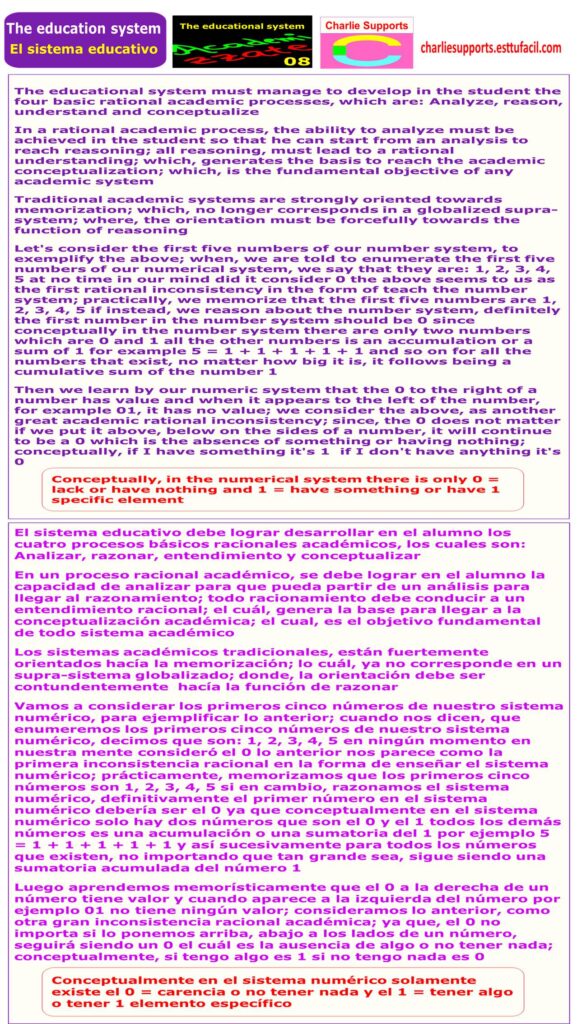
The educational system must manage to develop in the student the four basic rational academic processes, which are: Analyze, reason, understand and conceptualize
In a rational academic process, the ability to analyze must be achieved in the student so that he can start from an analysis to reach reasoning; all reasoning, must lead to a rational understanding; which, generates the basis to reach the academic conceptualization; which, is the fundamental objective of any academic system
Traditional academic systems are strongly oriented towards memorization; which, no longer corresponds in a globalized supra-system; where, the orientation must be forcefully towards the function of reasoning
Let’s consider the first five numbers of our number system, to exemplify the above; when, we are told to enumerate the first five numbers of our numerical system, we say that they are: 1, 2, 3, 4, 5 at no time in our mind did it consider 0 the above seems to us as the first rational inconsistency in the form of teach the number system; practically, we memorize that the first five numbers are 1, 2, 3, 4, 5 if instead, we reason about the number system, definitely the first number in the number system should be 0 since conceptually in the number system there are only two numbers which are 0 and 1 all the other numbers is an accumulation or a sum of 1 for example 5 = 1 + 1 + 1 + 1 + 1 and so on for all the numbers that exist, no matter how big it is, it follows being a cumulative sum of the number 1
Then we learn by our numeric system that the 0 to the right of a number has value and when it appears to the left of the number, for example 01, it has no value; we consider the above, as another great academic rational inconsistency; since, the 0 does not matter if we put it above, below on the sides of a number, it will continue to be a 0 which is the absence of something or having nothing; conceptually, if I have something it’s 1 if I don’t have anything it’s 0
Conceptually, in the numerical system there is only
0 = lack or have nothing and
1 = have something or have 1 specific element

Continuing with the exemplification of the first five numbers of our numerical system, we are going to confront the traditional educational system oriented towards memorization versus the educational system oriented towards deductive reasoning
We are going to proceed to carry out an analysis of the form used in the symbology of the first five numbers 1, 2, 3, 4, 5 if we realize, to form the figures used for said representation, the following forms predominate

If we observe, we realize that straight lines, horizontal lines, inclined lines and semicircles are used to form the symbols used in the first five numbers of our numerical system; for example, to form a 4, a straight line, a horizontal line, and a inclined line are used; by the shape, how lines and semicircles are combined; there is, no deductive reasoning capable of supporting the formation of the form of numbers as we currently know them; for this reason, we infer that said symbology is totally memorization system
We are going to try to infer a symbology that can be supported by deductive reasoning; for this purpose, we consider the following symbology:

We are going to give it a numerical value, the straight line = 1 and the two inclined lines joined = 2 so now, we are going to form the symbology to represent the first five numbers of the numerical system:
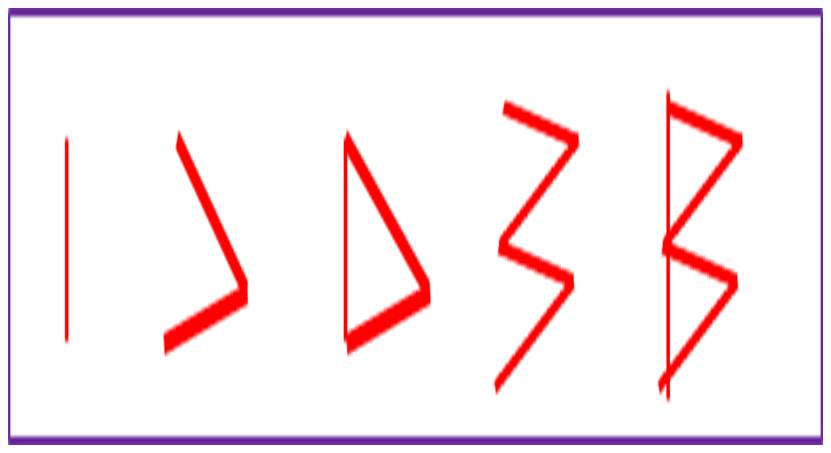
If we realize, we form 1 with a straight line; which, has a value of 1 to form the 2 we use the two inclined lines together; which have a value of 2 to form a 3 we use the straight line plus the joined inclined lines; since 2 + 1 = 3 to form 4 we use two pairs of joined inclined lines; since, as each pair is worth 2; then 2 + 2 = 4 and finally to form the 5 we use the symbology of 4 plus the straight line that has a value of 1 then 4 + 1 = 5 therefore, this new numerical symbology does have a support of deductive reasoning, everything educational system from the beginning should encourage deductive reasoning; since, part of an analysis which leads to an orderly reasoning that is the basis for achieving academic conceptualization
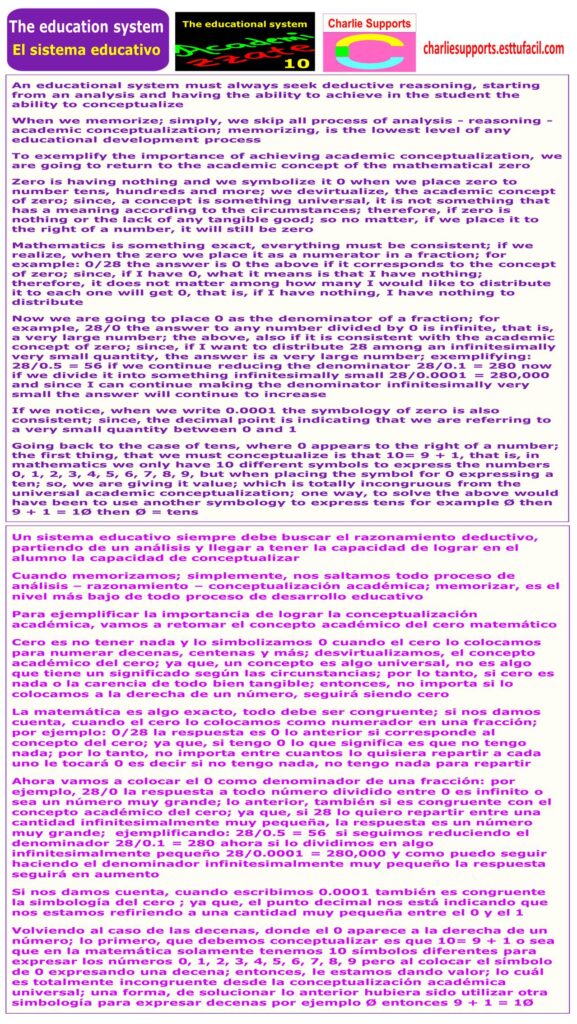
An educational system must always seek deductive reasoning, starting from an analysis and having the ability to achieve in the student the ability to conceptualize
When we memorize; simply, we skip all process of analysis – reasoning – academic conceptualization; memorizing, is the lowest level of any educational development process
To exemplify the importance of achieving academic conceptualization, we are going to return to the academic concept of the mathematical zero
Zero is having nothing and we symbolize it 0 when we place zero to number tens, hundreds and more; we devirtualize, the academic concept of zero; since, a concept is something universal, it is not something that has a meaning according to the circumstances; therefore, if zero is nothing or the lack of any tangible good; so no matter, if we place it to the right of a number, it will still be zero
Mathematics is something exact, everything must be consistent; if we realize, when the zero we place it as a numerator in a fraction; for example: 0/28 the answer is 0 the above if it corresponds to the concept of zero; since, if I have 0, what it means is that I have nothing; therefore, it does not matter among how many I would like to distribute it to each one will get 0, that is, if I have nothing, I have nothing to distribute
Now we are going to place 0 as the denominator of a fraction; for example, 28/0 the answer to any number divided by 0 is infinite, that is, a very large number; the above, also if it is consistent with the academic concept of zero; since, if I want to distribute 28 among an infinitesimally very small quantity, the answer is a very large number; exemplifying: 28/0.5 = 56 if we continue reducing the denominator 28/0.1 = 280 now if we divide it into something infinitesimally small 28/0.0001 = 280,000 and since I can continue making the denominator infinitesimally very small the answer will continue to increase
If we notice, when we write 0.0001 the symbology of zero is also consistent; since, the decimal point is indicating that we are referring to a very small quantity between 0 and 1
Going back to the case of tens, where 0 appears to the right of a number; the first thing, that we must conceptualize is that 10= 9 + 1, that is, in mathematics we only have 10 different symbols to express the numbers 0, 1, 2, 3, 4, 5, 6, 7, 8, 9, but when placing the symbol for 0 expressing a ten; so, we are giving it value; which is totally incongruous from the universal academic conceptualization; one way, to solve the above would have been to use another symbology to express tens for example Ø then 9 + 1 = 1Ø then Ø = tens
